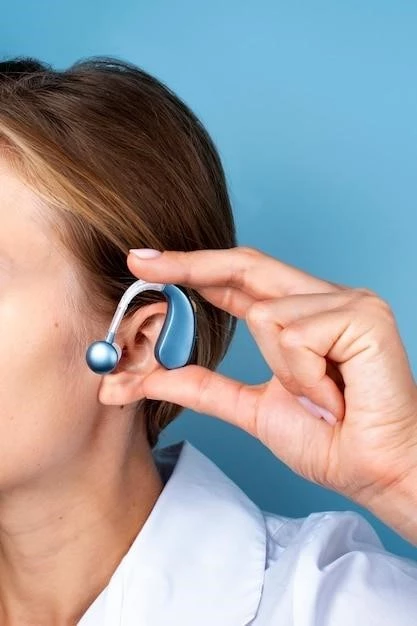Disease ⎻ Hearing Disorder
Hearing disorders encompass a range of conditions that affect auditory function. This article will explore the intricacies of hearing impairment, including its types, causes, symptoms, diagnosis, treatment options, lifestyle adjustments, impact on daily life, prevention strategies, research advancements, support systems, and dispelling myths surrounding hearing disorders.
I. Introduction to Hearing Disorder
Hearing disorders refer to a broad range of conditions that impact the auditory system’s ability to receive, process, and transmit sound waves effectively. Individuals affected by hearing impairment may experience hearing difficulty to varying degrees, ranging from mild to profound. This can significantly hinder their communication, social interactions, and overall quality of life. Understanding the complexities of hearing disorders is crucial in providing appropriate support and intervention for those affected. By delving into the types, causes, symptoms, diagnosis, treatment options, lifestyle modifications, and preventive measures related to hearing disorders, we can enhance awareness and promote optimal hearing health for individuals worldwide.
II. Types of Hearing Disorders
Hearing disorders encompass a spectrum of conditions that can affect individuals of all ages. Common types include conductive hearing loss, sensorineural hearing loss, mixed hearing loss, and central auditory processing disorder. Conductive hearing loss occurs when sound waves are unable to pass through the outer or middle ear, often due to blockages or structural issues. Sensorineural hearing loss involves damage to the inner ear or auditory nerve, affecting sound signal transmission to the brain. Mixed hearing loss combines elements of both conductive and sensorineural loss. Central auditory processing disorder relates to difficulties in processing auditory information in the brain. Understanding these various types is essential for accurate diagnosis and tailored treatment strategies.
III. Causes of Hearing Disorders
Hearing disorders can stem from various factors, including genetics, aging, prolonged exposure to loud noise, ear infections, ototoxic medications, head trauma, and diseases like meningitis or Meniere’s disease. Genetic predispositions may lead to congenital hearing impairments, while age-related changes such as presbycusis can impact hearing clarity over time. Continuous exposure to excessive noise levels, whether occupational or recreational, can cause irreversible damage to the auditory system. Ear infections, especially when left untreated, can result in temporary or permanent hearing loss. Certain medications can also have detrimental effects on hearing function. Understanding these diverse causes is fundamental in implementing preventive measures and targeted interventions to mitigate the risk of hearing impairment.
IV. Symptoms of Hearing Disorders
Symptoms of hearing disorders can manifest in various ways, depending on the type and severity of the condition. Common signs include difficulty understanding speech, asking others to repeat themselves frequently, turning up the volume on electronic devices, struggling to follow conversations in noisy environments, experiencing tinnitus or ringing in the ears, and feeling disoriented in spaces with poor acoustics. Children with hearing difficulties may exhibit delays in speech and language development. Individuals may also report feelings of social isolation, frustration, and fatigue due to the effort required to communicate effectively. Identifying these symptoms is crucial for early detection and prompt intervention to address underlying hearing issues.
V. Diagnosis of Hearing Disorders
Diagnosing hearing disorders involves a comprehensive evaluation by healthcare professionals specializing in audiology. The process typically includes a thorough medical history review, physical examination of the ears, and specialized tests to assess hearing function. Common diagnostic tests for hearing impairment may involve audiometry, tympanometry, auditory brainstem response (ABR) testing, otoacoustic emissions (OAE) testing, and speech testing. These assessments help determine the type and degree of hearing loss, as well as identifying potential underlying causes. By employing a combination of these diagnostic tools, healthcare providers can formulate an accurate diagnosis and develop personalized treatment plans tailored to each individual’s specific auditory needs.
VI. Treatment Options for Hearing Disorders
Treatment for hearing disorders varies based on the type and severity of the condition. Common interventions include hearing aids, cochlear implants, assistive listening devices, auditory training, and surgical procedures. Hearing aids are devices that amplify sound for individuals with mild to moderate hearing loss, improving their ability to perceive speech and environmental sounds. Cochlear implants are surgically implanted devices that directly stimulate the auditory nerve for those with severe to profound hearing loss. Assistive listening devices like FM systems and captioning services can enhance communication in various settings. Audiologists may also recommend auditory training to help individuals adapt to hearing aids and improve speech recognition. In some cases, surgical interventions to address structural issues or remove obstructions in the ear may be necessary. The choice of treatment modality is based on a thorough assessment and individualized care plan developed in collaboration with healthcare providers to optimize auditory function and improve quality of life for individuals with hearing difficulties.
VII. Lifestyle Changes to Manage Hearing Disorder
Managing a hearing disorder often involves incorporating lifestyle adjustments to optimize communication and overall well-being. Simple changes such as reducing exposure to loud noises, using ear protection in noisy environments, ensuring proper ear hygiene to prevent infections, and maintaining regular follow-ups with healthcare providers for monitoring and adjustments to hearing devices can significantly impact hearing health. Communication strategies like facing individuals when speaking, requesting quieter surroundings, utilizing visual cues, and advocating for accommodations in public spaces can enhance interaction and understanding. Embracing technology such as captioned telephones, smartphone apps for hearing assistance, and looping systems in public venues can further aid in communication. Additionally, adopting a healthy lifestyle with regular exercise, balanced nutrition, and stress management techniques can improve overall health and potentially mitigate factors contributing to hearing difficulties. By incorporating these lifestyle modifications, individuals with hearing disorders can proactively manage their condition and enhance their quality of life.
VIII. Impact of Hearing Disorder on Daily Life

Hearing disorders can have a profound impact on various aspects of daily life, affecting communication, social interactions, emotional well-being, and overall quality of life. Individuals with hearing difficulties may encounter challenges in understanding conversations, following instructions, participating in group settings, and engaging in activities that rely on auditory cues. This can lead to feelings of frustration, isolation, and decreased self-confidence. In professional environments, communication barriers may hinder job performance and career advancement. Social relationships may be strained due to miscommunications or difficulty engaging in social events. The cognitive load of constantly straining to hear can also lead to fatigue and mental exhaustion. Recognizing and addressing the impact of hearing disorders on daily life is essential for providing support, implementing effective coping strategies, and improving overall quality of life for individuals experiencing auditory challenges.
IX. Prevention of Hearing Disorders
Preventing hearing disorders involves implementing proactive measures to preserve auditory health and reduce the risk of developing hearing difficulties. Some key prevention strategies include managing exposure to loud noises by using ear protection in noisy environments, maintaining safe listening levels when using headphones or earbuds, taking regular breaks during loud events or activities, and limiting recreational activities with high noise levels. Timely treatment of ear infections and prompt medical attention for any signs of hearing loss or discomfort can help prevent potential complications. Avoiding the use of ototoxic medications unless necessary, practicing good ear hygiene to prevent infections, and seeking regular hearing screenings, especially for individuals at higher risk, are fundamental in early detection and intervention. By adopting these preventive measures and promoting awareness of healthy hearing habits, individuals can protect their auditory function and preserve their quality of life for years to come.
X. Research and Advancements in Treating Hearing Disorders
Ongoing research in the field of audiology is continually advancing our understanding of hearing disorders and expanding treatment options for individuals with auditory impairments. Innovations such as gene therapy hold promise for addressing genetic causes of hearing loss, while stem cell research explores regenerative potential in restoring damaged auditory cells. Technological advancements in hearing devices, such as improved cochlear implants with enhanced sound quality and speech recognition capabilities, offer individuals with severe hearing loss greater auditory access. Researchers are also investigating pharmaceutical interventions to protect and regenerate auditory nerves, potentially offering novel treatment avenues for sensorineural hearing loss. Collaborative efforts between clinicians, scientists, and engineers drive progress in developing personalized, effective interventions for diverse types of hearing disorders. By staying at the forefront of research developments and embracing innovative approaches, the field of audiology continues to improve outcomes and quality of life for individuals impacted by hearing impairments.
XI. Support Systems for Individuals with Hearing Disorders
Individuals with hearing disorders can benefit from a range of support systems designed to enhance their daily functioning and quality of life. Support networks may include audiologists, speech-language pathologists, hearing aid specialists, and otolaryngologists who provide clinical expertise and guidance in managing auditory challenges. Additionally, support groups and community organizations offer emotional support, education, and resources for individuals and families navigating hearing difficulties. Educational institutions and workplaces can implement accommodations such as captioning services, assistive listening devices, and communication strategies to facilitate effective communication for those with hearing impairments. Technology plays a crucial role in supporting individuals with hearing disorders, with advancements in smartphone apps, alerting devices, and telecommunication services enhancing accessibility. By accessing these support systems and resources, individuals with hearing disorders can receive the assistance and empowerment needed to overcome communication barriers, foster independence, and improve overall well-being.
XII. Myths and Misconceptions about Hearing Disorders
Myths and misconceptions about hearing disorders can perpetuate stigma and hinder appropriate care for individuals with auditory impairments. Common fallacies include the belief that only older adults experience hearing loss, while in reality, hearing disorders can affect individuals of all ages. Another misconception is that hearing aids make hearing perfect, whereas they simply amplify sound and may require adjustment periods. Some people wrongly assume that hearing loss is always a result of aging, neglecting the impact of genetic factors, noise exposure, and medical conditions. Additionally, there is a misconception that individuals with hearing impairments can simply ″try harder″ to hear, disregarding the physiological limitations of the auditory system. Dispelling these myths through education, awareness campaigns, and open dialogue is essential in fostering a supportive environment and promoting understanding for those living with hearing difficulties.
XIII; Conclusion
In conclusion, understanding the complexities of hearing disorders is crucial in addressing the multifaceted impact they have on individuals’ lives. From the various types and causes to the symptoms, diagnosis, and treatment options, a comprehensive approach is essential for effective management. Embracing lifestyle changes, prevention strategies, and leveraging support systems can enhance the well-being of those with auditory impairments. With ongoing research advancements driving innovation in treatment modalities and support systems, the future holds promise for improved outcomes and quality of life for individuals with hearing disorders. By dispelling myths and promoting awareness, we can create a more inclusive and supportive environment for those facing auditory challenges. It is through a collaborative effort of healthcare professionals, researchers, support networks, and individuals themselves that we can work towards a world where optimal hearing health is attainable for all.
